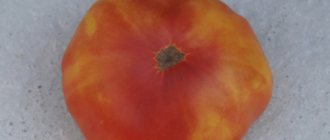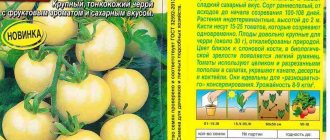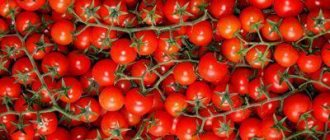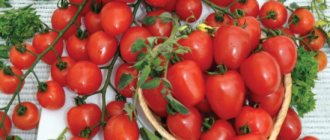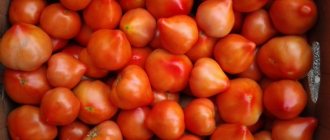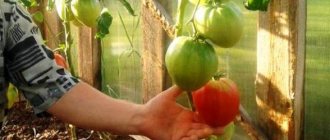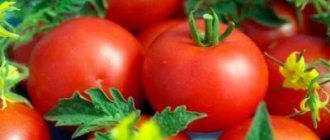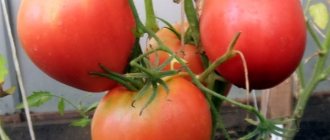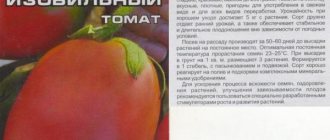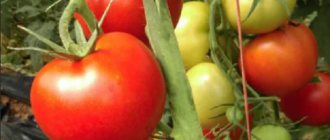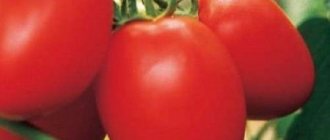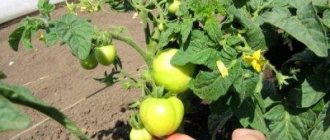| Ripening period: | 110-115 days from emergence (mid-season) |
| Shape, weight of fruits: | flat-round, 150-230 g |
| Determinacy: | height up to 180 cm in a greenhouse, up to 140 cm in open ground |
| Growing regions: | in open ground - the south of Russia, in other regions it is recommended to place the plant in a greenhouse |
| Productivity: | 10-12 kg per bush |
Modern gardeners pay special attention to the unusual appearance of plants. The Amethyst jewel tomato is a bicolor variety that changes the shade of the skin of the fruit during ripening. In addition to the bright, eye-catching color, the variety is characterized by a rich taste and high yield.
Description and characteristics of the variety
Indeterminate variety of tomatoes, reaching 180 m in height.
Medium-early, medium-leaved plant with spreading bushes. The original name of the variety is tomato 'Amethyst Jewel'. Recommended for cultivation in central regions due to suitable climatic conditions. The fruits are slightly flattened and round in shape. The tomato skin is quite durable, which prevents cracking. A distinctive feature is the color of the fruit - technically ripe tomatoes have a dark purple color, and fully ripe tomatoes have an almost black area near the stem with rays smoothly transitioning to a bright pink top. In cross section the fruits are pink in color.
The peculiarity of the variety is not only that the tomatoes have a non-standard coloring, but also that the stems can also have a bluish tint. Therefore, you should not immediately be afraid that the plant is sick.
Positive characteristics of the variety
The variety has many positive characteristics, including:
- high yield - from 4 to 9 kilograms per square meter;
- excellent marketability and transportability - the variety is stored for a long time and does not lose its marketability when transported over distances;
- undemanding in care, although you will have to tie up and remove excess leaves;
- recommended for cultivation in open and closed ground;
- mid-early ripening variety.
Features of culture
“Amethyst Jewel” is a universal tomato that is suitable for cultivation both in greenhouse conditions and in open ground. Original title: Amethyst Jewel.
This is a medium-growing indeterminate variety. The bushes are spreading, medium leafy.
The height of the bush rarely exceeds 1.5 meters, especially if it is grown in open ground conditions.
- The “Amethyst Jewel” variety is characterized by medium ripening periods; it begins to bear fruit approximately 110-115 days after germination, subject to greenhouse maintenance.
- High yield is one of the main advantages. The ovaries are formed well, without gaps. Dense clusters of 5-6 fruits are formed.
- Fruiting lasts until September; in a greenhouse it can last even longer.
In Russia, this tomato variety is recommended to be grown in greenhouses, and only in the middle zone - in open ground. The description of the variety confirms this.
Amethyst Jewel is a mid-early variety. Its creator is the American breeder Brad Gates.
The plant is an indeterminate bush up to 180 cm high. They require pinching.
The flattened, rounded fruits weigh 150-210 g. Ripe tomatoes have dense skin that does not crack. Their color differs at different stages of maturation. Technically ripe fruits are light purple, and fully ripe ones are black near the stem and brightly colored at the top.
The tomatoes are pink when cut. They are an excellent ingredient in salads and preserves. A fruity, exotic shade gives them a piquant taste.
Let us list the main characteristics of the variety:
- suitable for growing in greenhouses and outdoor gardens;
- spreading bushes, medium foliage;
- the stem in the area does not extend above 1.5 m;
- the growing season in a greenhouse is 110-117 days;
- each cluster contains 5-6 fruits; the variety's yield is high;
- tomatoes are stored for a long time and are resistant to long-term transportation;
- the plant bears fruit for a long time: in open areas until September, and in a greenhouse - even longer;
- The Amethyst Jewel variety is immune to common infections.
Growing and care
Sowing of seeds is carried out 60-65 days before planting in the ground. The seeds have good and abundant germination, so when sowing in a common container, you will need to plant them in separate pots or freer containers.
The characteristics of the variety indicate that the stems of the sprouts are characterized by a bluish tint.
“Amethyst Jewel” does not tolerate temperature changes very well, so young shoots must be protected from drafts and overheating of the air. It is recommended to plant bushes at a density of 3-4 plants per square meter.
After planting in the ground, tomatoes will not require special care, except for timely watering, weeding, hilling and periodic feeding.
Sunlight plays a big role in the color of tomatoes of the “AmethystJewel” variety: the more light that falls on the fruit, the darker its color will be. Therefore, if you grow "Amethyst Jewel" in the shade, the color of the tomatoes will not have such a rich purple color, but will be more pink.
This tomato treasure will amaze with its extraordinary color, surprise with its fertility and will not disappoint with its sweet taste.
Speaking of tomatoes, we are used to seeing ordinary red tomatoes in garden beds. However, not all varieties produce such fruits. More and more original new products are appearing. The Amethyst Jewel tomato attracts lovers of everything unusual. What kind of variety is this, how to grow it, what is the yield of the variety, reviews from farmers - these and other questions will be discussed in the article.
Each cluster contains 5-6 fruits weighing 150-200 grams. Amethyst Jewel has a rich flesh. Tomato flavor with exotic notes will add some piquancy to the dishes. The fleshy fruit is well suited for processing into tomato paste, ketchup or snack. Suitable for whole fruit canning.
60-65 days after preparing the seedlings, the seedlings can be moved to their place of permanent growth. Drafts and too low or high temperatures should be avoided - this will adversely affect the fruiting of the bushes.
The plant is characterized by medium foliage, so it is recommended to leave 70-80 cm between bushes for passage.
- Timely watering. It should be done as the soil dries out. It is best to water with warm water early in the morning or in the afternoon.
- Stepsonning. To get rid of excess vegetation, it is recommended to trim the stepsons. This will allow all the plant’s forces to be directed to feeding the fruits, and not to maintaining the leaves in shape. This also allows the fruits to be fully saturated with sunlight and obtain a characteristic color.
- Weeding and loosening. Produced for improved air-gas conditions and moisture retention. This is also considered a preventive measure for weeds.
- Feeding. Amethyst Jewel tomatoes require regular fertilization with mineral and organic substances.
Description
The tomato belongs to the mid-season category, the variety was bred in the USA. The height of the bush reaches 1.8 m; pinching is considered a mandatory condition for care. Ripe tomatoes have a round, flattened shape; the weight of one tomato reaches 200 g. The thick skin is prone to cracking, and the color of the fruit changes as it ripens.
Features of the variety:
- the possibility of growing in beds, in greenhouse conditions;
- spreading bushes of medium foliage;
- height 1.5 m in open ground;
- fruiting - after 110-117 days, long period of fruiting;
- resistance to long-distance transportation;
- disease resistance;
- increased productivity.
When grown in garden beds, the ripening period occurs in September; in a greenhouse, tomatoes ripen later. The main disadvantage of the variety is its sensitivity to weather changes. Tomato does not tolerate cold temperatures and dry air. The optimal temperature for the plant is 25 degrees. The middle strip is best suited for planting in the garden.
Description of purple tomato Amethyst Jewel and agricultural cultivation techniques
The Amethyst Jewel variety, or Amethyst Jewel, is a tomato with an unusual color and exotic taste of the fruit. Tomatoes were bred in California (USA), but they also grow well in central Russia. The variety can also be found with the name “Amethyst Treasure”.
General characteristics of the variety
The characteristics and description of the variety classify it as an indeterminate tomato. The average height of a plant in a greenhouse can reach 1.5 m, but in open ground a tomato is usually lower - up to 1 m. The plant needs staking and shaping. It is recommended to grow the Amethyst Jewel tomato in 2-3 stems to get a higher yield from 1 bush. For compacted plantings (in a greenhouse), only 1 stem can be left (see photo).
The foliage of the variety is average, the plant does not form excess green mass, but it is better to remove some of the leaves in the lower tier as flower clusters form. This creates greater breathability of the plantings and prevents the spread of fungal infections.
The first flower clusters are formed above the 6-8 leaves, and then appear every 2-3 leaf tiers. Despite the small number of tomatoes in each cluster (5-6 pcs.), it is possible to collect about 10 kg of fruit from the bush.
The Amazing Fruits of the Amethyst Jewel
This exotic tomato variety belongs to the bicolor group. The color of the fruit combines 2 primary colors, as shown in the photo. Even in an unripe state, the fruits have a dark color on the shoulders (closer to the stalk), and the tip is lighter. The violet hue, continuous near the stalk, gradually splits into separate stripes and dots. When the fruit ripens, the dark color remains, but the tip becomes pink. The combination of colors is reminiscent of the play of shades of an amethyst gem, for which the variety received its original name.
Not all gardeners like the taste of ripe Amethyst Jewel tomatoes. Reviews agree on one thing: the fruits lack the sourness characteristic of tomatoes. The dessert's sweet, almost caramel-like flavor is distasteful to many. Therefore, this variety is not suitable for lovers of traditional tomatoes, but children will certainly like it.
The disadvantages of Amethyst Jewelry include:
- thin skin;
- property of cracking with sudden changes in temperature.
But tomatoes, collected completely intact, are distinguished by their high keeping quality and the ability to ripen in boxes within 1-2 months after being picked from the bush. This allows you to extend the period of eating fresh vegetables from your garden.
The average weight of the fruit is 130-200 g. The shape of the tomato is flat-round, suitable for canning in its entirety. Despite the thin skin, fruits in marinades retain a dense pulp consistency and do not fall apart. Amethyst Jewel tomatoes can also be used to make juice or lecho, since only the skin has an exotic color. The pulp is rich pink in color, with numerous small seed chambers. The unusual taste of the fruit is also suitable for making jam or preserves from tomatoes.
The variety is not a hybrid. Seeds from plants grown on your own plot can be left for the reproduction of the variety. But to preserve the color characteristic of Amethyst Jewel, these bushes should not be planted next to red-fruited varieties.
Agricultural technology varieties
When grown in a greenhouse, fruits may be affected by gray rot (those removed will rot at the stalk). The variety is practically immune to fusarium, late blight and other diseases common in central Russia. But domestic vegetable growers should be aware that it is very demanding on weather conditions: the yield of Amethyst Jewel is reduced both at too high and at low temperatures.
The optimal interval for growing is +22…+25 °C. In regions with cold summers, it is better to cultivate tomatoes in greenhouse conditions.
The germination rate of purchased seeds is not very high: out of 10 seeds sown. most often 4-6 sprouts sprout. This must be taken into account when purchasing planting material. Sowing is carried out at the end of March, using standard technology:
Description of the tomato Amethyst Jewel
The tomato variety Amethyst Jewel gives excellent results when grown in a greenhouse and in open ground. The original name was Amethyst Jewelry. The plant has an average ripening period, is small in size and produces a rich harvest.
Characteristics of the bush
The bushes grow of medium size, with slight spreading and foliage. In greenhouse conditions it can reach 1.2-1.3 m; in open ground it rarely grows up to 1 m. The stems begin to bend, so gartering and pinching is required. The best option is to form a bush with 2-3 stems.
Description of fruits
The tomatoes are round and slightly flattened, firm to the touch. The peel does not crack, is glossy and smooth. Ripe fruits have a gradient in color transition: from a red-pink hue at the top to purple at the shoulders. Average weight varies around 200 g.
Inside, the fruits are fleshy, dense, sweetish-salty with a fruity aftertaste. Not many seeds. The pulp becomes bright red after ripening.
Another interesting variety is the Striped Chocolate Tomato.
Tomatoes can withstand long-term storage without losing their presentation or taste. The vegetable is suitable for canning and fresh consumption.
Productivity and fruiting
The Amethyst Jewel tomato produces a rich harvest. Each bush bears several clusters containing up to 5-6 fruits. They tie well, without pacifiers. The harvest is harvested until September, and in the greenhouse longer - until November.
Resistance to diseases and pests
The advantage of the variety is its resistance to many fungal diseases and pests. If timely prevention is carried out, crop loss due to infection can be easily avoided.
Advantages and disadvantages of the variety
Amethyst jewelry has a lot of positive characteristics. Among them:
- a bountiful harvest;
- immunity and resistance to pests and fungal diseases;
- excellent taste;
- rich aroma;
- unusual, beautiful color;
- versatility of use;
- long-term storage and transportation.
But there are also a number of disadvantages. This is a very demanding variety that requires special growing conditions. The Amethyst Jewel tomato does not tolerate temperature changes, drought, low temperatures, or increased humidity. Optimal temperature is +25 degrees. Therefore, the best territory for growing Amethyst Jewel is the regions of the middle zone.
In addition, tomatoes require constant tying and pinching, otherwise they begin to stretch.
The Amazing Fruits of the Amethyst Jewel
This exotic tomato variety belongs to the bicolor group. The color of the fruit combines 2 primary colors, as shown in the photo. Even in an unripe state, the fruits have a dark color on the shoulders (closer to the stalk), and the tip is lighter. The violet hue, continuous near the stalk, gradually splits into separate stripes and dots. When the fruit ripens, the dark color remains, but the tip becomes pink. The combination of colors is reminiscent of the play of shades of an amethyst gem, for which the variety received its original name.
Not all gardeners like the taste of ripe Amethyst Jewel tomatoes. Reviews agree on one thing: the fruits lack the sourness characteristic of tomatoes. The dessert's sweet, almost caramel-like flavor is distasteful to many. Therefore, this variety is not suitable for lovers of traditional tomatoes, but children will certainly like it.
The disadvantages of Amethyst Jewelry include:
- thin skin;
- property of cracking with sudden changes in temperature.
But tomatoes, collected completely intact, are distinguished by their high keeping quality and the ability to ripen in boxes within 1-2 months after being picked from the bush. This allows you to extend the period of eating fresh vegetables from your garden.
The average weight of the fruit is 130-200 g. The shape of the tomato is flat-round, suitable for canning in its entirety. Despite the thin skin, fruits in marinades retain a dense pulp consistency and do not fall apart. Amethyst Jewel tomatoes can also be used to make juice or lecho, since only the skin has an exotic color. The pulp is rich pink in color, with numerous small seed chambers. The unusual taste of the fruit is also suitable for making jam or preserves from tomatoes.
The variety is not a hybrid. Seeds from plants grown on your own plot can be left for the reproduction of the variety. But to preserve the color characteristic of Amethyst Jewel, these bushes should not be planted next to red-fruited varieties.
Preparing seedlings
Seeds should be sown 60-67 days before planting tomatoes in the garden. The grains germinate well and amicably.
First, the seeds are disinfected (if they were obtained independently) by soaking them in the prepared solution. It can be prepared by adding 1 g of manganese or 0.5 g of soda or aloe juice (50 ml by 50 ml) to 100 ml of water.
The soil is prepared in advance. You can purchase it in a special store. Otherwise, the ground will be disinfected. To do this, just heat it in the oven for 10 minutes at 200 °C, or pour boiling water or a strong solution of potassium permanganate on it. The seeds are laid out in rows on moist soil and covered with a thin layer of soil on top, then the soil is lightly moistened.
The box with seeds is covered with plastic wrap or glass and placed in a warm place for germination.
Experts recommend placing two seedlings in one glass. When they grow to 13-15 cm, the stems are tied with nylon thread. Gradually they grow together, and the tip of the weak one is pinched off. As a result, a bush with a powerful stem will be formed.
Sowing of seeds is carried out 60-67 days before planting young plants. Tomato seeds germinate together. The soil mixture is prepared in advance. It is better to buy it at a farm store. The seeds are laid out on a damp soil surface and sprinkled with a small layer of earth or peat chips. The top soil layer can be slightly moistened with a watering can.
After the sprouts appear, the protection is removed
As soon as leaves form, carefully move the seedlings into small containers
To grow strong bushes, you need to place 2 shoots in each glass. When their height reaches 13-15 cm, the stems are tied with nylon thread. They grow together, and the upper part of the weak plant is pinched. The result is 1 bush with a strong stem.
For proper development of seedlings, you need to keep the pots in a bright room. The temperature there should remain 23-24 degrees throughout the day. It can be reduced after 1.5-2 weeks. Then the first brushes of the Amethyst Jewel will develop correctly.
The temperature is lowered over the course of two weeks: during the day to 19, at night to 17. You cannot rush and change the indicators abruptly, because of this the first brush may form incorrectly. In indeterminates, it should form between 9 and 10 leaves. Otherwise, yields may fall.
After transplanting tomatoes, you need to slightly moisten the soil. The bushes should be located at a distance of 51-56 cm from each other. The optimal distance between the beds is 70-80 cm.
The holes are made in a checkerboard pattern to make it easier to monitor the condition of the plants and fix them.
How to grow seedlings
Sowing of seeds is carried out 60-67 days before planting young plants. Tomato seeds germinate together. The soil mixture is prepared in advance. It is better to buy it at a farm store. The seeds are laid out on a damp soil surface and sprinkled with a small layer of earth or peat chips. The top soil layer can be slightly moistened with a watering can.
To prevent the soil from drying out, you need to cover it with polyethylene or glass. Before emergence, the container should be in a warm room, at a temperature of +23.
After the sprouts appear, the protection is removed
As soon as leaves form, carefully move the seedlings into small containers
To grow strong bushes, you need to place 2 shoots in each glass. When their height reaches 13-15 cm, the stems are tied with nylon thread. They grow together, and the upper part of the weak plant is pinched. The result is 1 bush with a strong stem.
For proper development of seedlings, you need to keep the pots in a bright room. The temperature there should remain 23-24 degrees throughout the day. It can be reduced after 1.5-2 weeks. Then the first brushes of the Amethyst Jewel will develop correctly.
The temperature is reduced over two weeks: during the day to +19, at night to +17. You can’t rush and change the parameters suddenly; because of this, the first brush may not form correctly. In indeterminates, it should form between 9 and 10 leaves. Otherwise, yields may fall.
When moving seedlings, you need to protect them from drafts and temperature changes. Seedlings should be in an upright position and covered with polyethylene.
After transplanting tomatoes, you need to slightly moisten the soil. The bushes should be located at a distance of 51-56 cm from each other. The optimal distance between the beds is 70-80 cm.
The holes are made in a checkerboard pattern to make it easier to monitor the condition of the plants and fix them.
Advantages and disadvantages of the variety
Despite the instability of the variety, the tomato has a number of advantages that set it apart from others:
- The tassels are tied very tightly, from bottom to top, without gaps. Each cluster produces 5-6 fruits.
- The skin is dense, cracking is not typical.
- High resistance to most tomato diseases.
- In open ground it grows spreading, no higher than 1.5 m.
- Fruiting is long-lasting - the harvest in the greenhouse can be harvested until the end of September, and even later in greenhouse conditions.
- Good shelf life (up to 2 months after harvest).
- The tomato is valued for its beauty and taste in salads and is excellent for processing.
The disadvantages include:
- ordering seeds only from private breeders;
- fluctuations in fruit weight;
- dependence of taste and appearance on the presence of sunlight.
Agrotechnics of cultivation
The variety is intended for cultivation in open areas. But gardeners also use it for growing in a greenhouse. The description of the variety says that plants can be propagated by growing seedlings; 4–5 seedlings are placed on one square meter.
When cultivated in a greenhouse, the variety can be grown in two or three stems, in open areas - in one, maximum two.
Seeds for seedlings are sown in mid-March; when 2-3 permanent leaves are formed, the plants are planted in separate containers. Planted in a greenhouse in mid-May, in open ground in early June. The bushes are tied to a support and cared for.
See also
Description of the tomato variety Zoloto Vostok, its characteristics and yieldRead
Description of fruits
- Fleshyness combined with a small amount of seeds is the main property that will delight consumers. What is also attractive is that, despite the color of the tomato shell, the inner cavity has a bright red tint, filled with juice and rich taste.
- The tomato flavor of the fruit is ideally combined with a slight fruity note, resulting in sweetness and spiciness.
- The fruits are not large, so the weight is no more than 200 grams, but the combined weight of several fruits growing on one branch can cause damage to the stem, so tying is necessary to evenly distribute the load.
- Due to their dense peel, the fruits can withstand long-term storage or transportation, so if all conditions are created, you can enjoy the taste of tomatoes for a long time.
- This type of tomato is ideal for salads and preserves due to its structure and spiciness. If we talk about preservation, the fruits will not crack or deform, which allows them to ideally retain their basic taste and aromatic properties for a long time. The variety has proven itself in creating culinary masterpieces due to its appearance and taste.
Temperature and placement
For proper development of seedlings, they should be kept in a bright room with a temperature of 23-24 °C. Then they begin to gradually reduce it. This promotes the development of the hands.
After a couple of weeks, the temperature is lowered to 19 °C during the day and 17 °C at night. This is how the first brush is formed. It is necessary that it forms between the 9th and 10th sheets. Otherwise, the harvest volume will be greatly reduced.
When transporting seedlings, tomatoes should be protected from drafts and sudden temperature changes. Seedlings are transported in a vertical position, covered with film.
Experienced gardeners advise arranging bushes in a checkerboard pattern, this makes it easier to care for them.
Characteristics of the variety
Amethyst Jewel tomatoes have excellent characteristics. This variety has almost no disadvantages. It produces good yields, has a wide range of uses, and is also resistant to diseases and pests.
Productivity and fruiting
A mid-season tomato of the Amethyst Jewel variety becomes ready for harvest approximately 4-5 months after the first shoots appear. The duration of ripening depends on the conditions in which the tomatoes are grown.
This variety can be cultivated both in open soil and in a greenhouse. Tomato is characterized by long fruiting. In open ground conditions it will continue to ripen in September, in a greenhouse even later.
Area of application of fruits
In reviews of the Amethyst Jewel tomato variety, many note that vegetables can be used for a variety of purposes. These tomatoes, which have a pleasant taste and aroma, can be consumed both raw and processed. The fruits can be stewed, fried, canned, and also used to make juice. Tomatoes go well with meat dishes.
Resistance to diseases and pests
According to the description of the tomato variety Amethyst Jewel, the plant is absolutely resistant to all kinds of diseases and insect pests that often affect tomatoes of other varieties.
Advantages and disadvantages of the variety
Tomatoes of the Amethyst Jewel variety have many positive qualities, which include the following indicators:
- abundant yield;
- immunity to disease;
- pest resistance;
- excellent taste;
- pleasant aroma;
- transportation over long distances;
- possibility of long-term storage;
- attractive appearance;
- unusual colors;
- universal purpose;
- Possibility of cultivation both in open soil and in greenhouse conditions.
Among the disadvantages of this variety of tomatoes, the following characteristics can be distinguished:
- the need for garters;
- sensitivity to temperature changes.
Tomato Amethyst Jewel: characteristics and description of the variety
Today, there are many varieties of tomatoes that attract attention with their unusual shape or color.
These varieties include the Amethyst Jewel tomato, which is a bicolor. This exotic species was bred by California breeding specialist Brad Gates. The original name of the variety of these tomatoes is Amethyst Jewel. The Amethyst Jewel tomato is an indeterminate variety. If you grow this crop in open soil, it can grow to approximately 1 m. In a greenhouse, if all necessary care rules are followed, the plant usually reaches about 1.8 m in height.
Tomato bushes of the Amethyst Jewel variety are spreading. They are characterized by medium foliage. Tomato leaves are quite large. They are painted in light green color.
Typically, a crop of this variety is formed into 2 or 3 stems. They are thick and strong enough to support large amounts of harvest, but still require staking. The tomato inflorescences of the Amethyst Jewel variety are simple.
This variety of tomato is mid-season. If it is cultivated in a greenhouse, fruiting will begin approximately 4 months after the appearance of the first shoots. In open ground conditions, the ripening process will take longer.
The tomato variety Amethyst Jewel was bred in the USA by Californian breeders. The purpose of creating the culture was to obtain a species suitable for cultivation in open ground and in a greenhouse. The original color of tomatoes is designed to attract the attention of collectors of unusual varieties.
Amethyst jewel tomatoes are considered tall, the stem reaches 180 cm. But, when grown in open ground, the height of the bush is limited to 130-150 cm. The tomato is formed into 2-3 stems, a garter to a support is required.
The Amethyst tomato is characterized by extended fruiting, lasting one and a half to two months.
The fruits of the plant have a round, slightly flattened shape. Large specimens show faint ribbing. The skin is dense and resistant to cracking. Thanks to its durable skin, the Amethyst tomato can be stored for up to 15 days and transported over long distances.
The color of the fruit shell changes depending on ripeness:
- in the phase of technical maturity, the peel has a red-violet hue, with pink strokes near the stalk;
- with the onset of full ripening, the fruit becomes black and purple (the color of the stalk is more saturated).
The photo presented shows the rich and deep color of the skin of the fruit.
The tomato pulp is bright red, fleshy, with a small number of seed chambers. The taste of the fruit is sweet, with unobtrusive fruity notes. The harvested crop is used fresh: in salads, cut into sandwiches. The fruits can be salted and pickled; when poured with hot marinade, they do not crack.
The yield of the variety is high, provided that the growing rules are followed. The plant is demanding on soil fertility and cannot tolerate low air temperatures. Comfortable temperature indicators for growing tomatoes are 24 - 25 degrees. Having created such conditions for his treasure, the gardener will be able to collect about a bucket of full-fledged fruits from each plant.
Characteristics of the variety will be incomplete without mentioning the plant’s resistance to disease. The tomato is resistant to the main diseases of tomatoes: bacteriosis, mosaic, late blight, blight.
Under unfavorable weather conditions (high humidity, low air temperature), the Amethyst tomato needs preventive spraying, along with other plants.
The Amethyst Jewel tomato is classified as a medium-ripening tomato. The author of the variety is Bradd Gates (USA, California). There is another name for these tomatoes - “amethyst treasure”. Original title: Amethyst Jewel. The bushes grow tall (over 180 cm) and require pinching. The leaves are quite large, light green in color. The inflorescences are simple.
The fruits have a round, flattened shape and weigh 150-210 grams. The skin of tomatoes is dense and does not crack. Tomatoes have an original color, bicolor, it changes from light purple during the period of technical maturity to black near the cuttings, turning into bright pink at the top during final ripening. Gardeners characterize the color as blue-pink. The flesh of the tomatoes is pinkish in color.
Amethyst Jewel tomatoes, the variety of which is described in the article, go well with other vegetables in salads and are perfect for preparations. The variety has a spicy flavor with a hint of fruity notes.
The Amethyst Jewel tomato is classified as a medium-ripening tomato. The author of the variety is Bradd Gates (USA, California). There is another name for these tomatoes - “amethyst treasure”. Original title: Amethyst Jewel. The bushes grow tall (over 180 cm) and require pinching. The leaves are quite large, light green in color. The inflorescences are simple.
Amethyst Jewel tomatoes have excellent characteristics. This variety has almost no disadvantages. It produces good yields, has a wide range of uses, and is also resistant to diseases and pests.
A mid-season tomato of the Amethyst Jewel variety becomes ready for harvest approximately 4-5 months after the first shoots appear. The duration of ripening depends on the conditions in which the tomatoes are grown.
This variety can be cultivated both in open soil and in a greenhouse. Tomato is characterized by long fruiting. In open ground conditions it will continue to ripen in September, in a greenhouse even later.
In reviews of the Amethyst Jewel tomato variety, many note that vegetables can be used for a variety of purposes. These tomatoes, which have a pleasant taste and aroma, can be consumed both raw and processed. The fruits can be stewed, fried, canned, and also used to make juice. Tomatoes go well with meat dishes.
According to the description of the tomato variety Amethyst Jewel, the plant is absolutely resistant to all kinds of diseases and insect pests that often affect tomatoes of other varieties.
Tomatoes of the Amethyst Jewel variety have many positive qualities, which include the following indicators:
- abundant yield;
- immunity to disease;
- pest resistance;
- excellent taste;
- pleasant aroma;
- transportation over long distances;
- possibility of long-term storage;
- attractive appearance;
- unusual colors;
- universal purpose;
- Possibility of cultivation both in open soil and in greenhouse conditions.
Among the disadvantages of this variety of tomatoes, the following characteristics can be distinguished:
- the need for garters;
- sensitivity to temperature changes.
The variety has many positive characteristics, including:
- high yield - from 4 to 9 kilograms per square meter;
- excellent marketability and transportability - the variety is stored for a long time and does not lose its marketability when transported over distances;
- undemanding in care, although you will have to tie up and remove excess leaves;
- recommended for cultivation in open and closed ground;
- mid-early ripening variety.
How to carry out stepsoning?
As soon as the first inflorescence forms in the axils, side shoots begin to grow. At this time, you should start forming a bush. This is necessary so that the plant does not devote all its energy to increasing the green mass and does not reduce the yield.
Any shoots and ovaries formed in August should be cut off. They also pinch the growing points, thereby helping the plant not to waste energy on growth.
During the season, bushes are pruned weekly. One, two or three stems are enough to form a bush. In central Russia, one or two stems are enough. Despite the fact that the yield is high and there is a lot of fruit, bushes with powerful stems are quite capable of withstanding such a load. If it was initially planned to leave one stem for the formation of bushes, you can place the seedlings more densely than was previously proposed.
Distinctive features of the variety
Amethyst rhinestone is a variety characterized by high fruiting, which ensures a high yield of product per square meter. However, an interesting fact is that when grown in open ground, seedlings can reach half a meter in height. And that is why special tightening is required when growing to avoid overloading and even damage to the bush.
There are the following features when growing tomatoes of the Amethyst Treasure variety:
This tomato variety has an average ripening speed (as a result, 100-115 days after planting, you can pick juicy and tasty fruits
But this feature applies only to greenhouse cultivation of fruits, since in such conditions optimal temperature and humidity are created, for which reason it has a positive effect on subsequent yields. High yield is an important positive quality, which became the basis for the development of demand for this product. Healthy plant clusters can provide mainly 5 dense fruits filled with juice and nutrients. Seedlings can bear fruit until September, and if we consider growing in a greenhouse, the period increases significantly. Produces dense and tasty tomatoes, filled with a bright red color, which creates attractiveness combined with richness of taste. A plant from a nearby selection was vaccinated against various diseases, so Pomona’s gifts will delight you with their taste and aroma
And the process of growing uninhabited (= sparsely populated) is accompanied by diseases and infections of the plant. Even the most persistent diseases of the plant will not cause disruption of flowering and fruiting of tomatoes.
Also, transplants cope with temperature changes; hot days and cold nights will not create difficulties for the plant, and fruiting will be at a high level. But active fruiting is ensured by maintaining a temperature above 25 degrees Celsius.
Tomato Amethyst Jewel
photo author Mira Tom
Description and characteristics of the tomato variety Amethyst Jewel, reviews, photos
The original name of this tomato is Amethyst Jewel .
Mid-season, medium-growing, productive tomato variety of Brad Gates. Recommended for growing in greenhouses and open ground.
The height of the bush in the greenhouse is up to 1.2 meters, in the greenhouse it is slightly less. Requires tying to the support and pinning. It is best to form a plant in 2 or 3 stems.
Basic qualities of fruits
photo by Alexey Kulik
The fruits are flat-round, dense, at the ripe stage pink in color from the top and purple from the shoulders, weighing up to 200 grams, fleshy, sweet, tasty. These tomatoes are well suited for both fresh consumption and canning.
The variety is resistant to major tomato diseases.
We gave this variety the highest score in all respects - beauty, productivity and taste.
Features of cultivation, planting and care
photo author Tatyana Tarasevich
The photo shows tomato seedlings Amethyst Jewel.
We recommend sowing the seeds of this variety of tomatoes for seedlings 60-65 days before the intended planting in a permanent place. Seedlings dive at the stage of two true leaves. When planting seedlings in a permanent place per 1 sq. Place up to 3 plants per meter of prepared area; when forming into 1 stem - up to 4.
Further care for tomatoes consists of timely watering, fertilizing with complex mineral fertilizer, pinching and preventive measures to protect against diseases and pests.
Tomatoes Amethyst Jewel on video
If you grew these tomatoes, please write whether you liked them or not. What was the yield and taste of the fruits like under your climatic conditions? Briefly describe the advantages and disadvantages of this tomato in your opinion. If possible, attach a photo of your tomatoes to your comment. Thank you!
Description of the variety
American breeder B. Gates introduced the Amethyst Jewel to the world in 2013. Unfortunately, the variety was released somewhat prematurely, “unstable.” It is precisely because varietal characteristics have not been fixed that tomatoes are very variable in shape, weight and color from different seed sellers.
The breeder himself declares the following characteristics of the tomato:
- weight 30-85 g;
- quantity in brush 5-7;
- round fruits;
- The color of the tomatoes is pink with blue streaks at the base;
- the productivity is high.
However, a lot has changed since 2013, and the variety has decisively expanded the boundaries of the described standards. The weight of its fruits ranges from 30 to 250 g; bush height from 1.3 to 2.5 m; Outwardly, tomatoes can be either round or irregular in shape. The only thing you can be sure of is the yield – it is consistently high.
The anthocyanin pigment (responsible for the ink shoulders of the tomato) endowed the Amethyst Jewel with its special charm and taste. If the tomatoes receive more sunlight, the color will be a rich, dark purple. Tomatoes deprived of sunlight will show more pink.
The cut flesh is red-pink, fleshy, with a moderate amount of seeds. The taste is piquant, enveloping, with a delicate fruity note.
According to ripening time | By type of growth | By type of use | By growing method | Fruit weight (g) | Productivity (kg/m2) | Fetal characteristics |
| Mid-ripe, 110-115 days | Indeterminate, 180-250 cm | Universal | For greenhouses and open ground | Up to 250 g | Greenhouse: 6-9 kg Open ground: 5-7 kg | Pink-purple, round and irregular in shape |
Description of the tomato variety Amethyst Jewel and its characteristics
Recently, tomato experts have been increasingly interested in “bi-colors” - multi-colored tomatoes. A large number of exotic varieties were developed by the American breeder from California, Brad Gates, including such a tomato treasure as the “Amethyst Jewel” tomato.
Features of the variety
“Amethyst Jewel” is a universal tomato that is suitable for cultivation both in greenhouse conditions and in open ground. Original title: Amethyst Jewel.
This is a medium-growing indeterminate variety. The bushes are spreading, medium leafy.
The height of the bush rarely exceeds 1.5 meters, especially if it is grown in open ground conditions.
- The “Amethyst Jewel” variety is characterized by medium ripening periods; it begins to bear fruit approximately 110-115 days after germination, subject to greenhouse maintenance.
- High yield is one of the main advantages. The ovaries are formed well, without gaps. Dense clusters of 5-6 fruits are formed.
- Fruiting lasts until September; in a greenhouse it can last even longer.
The plant is very resistant to most diseases, but is quite capricious to weather conditions. It is difficult to tolerate sultry heat and severe cold. The optimal temperature for tomatoes to develop normally and bear fruit abundantly is +25 degrees.
In Russia, this tomato variety is recommended to be grown in greenhouses, and only in the middle zone - in open ground. The description of the variety confirms this.
Description of fruits
The shape is flat-round. The skin is dense and smooth, not prone to cracking.
The tomato has an unusual color: from the shoulders, the deep purple color is splashed with blue-violet flashes to the warm pink color of the top.
- The flesh is fleshy, with a small amount of seeds, and when fully ripe has a rich red color.
- The tomato has a pronounced, enveloping tomato taste with exotic fruity notes.
- The size of the fruit is small or medium, no more than 200 grams.
- Tomatoes store well and are resistant to transportation.
“Amethyst Jewel” tomatoes look very interesting and unusual in salads and after preservation. This variety is excellent for wide use in cooking.
Growing and care
Sowing of seeds is carried out 60-65 days before planting in the ground. The seeds have good and abundant germination, so when sowing in a common container, you will need to plant them in separate pots or freer containers.
The characteristics of the variety indicate that the stems of the sprouts are characterized by a bluish tint.
“Amethyst Jewel” does not tolerate temperature changes very well, so young shoots must be protected from drafts and overheating of the air. It is recommended to plant bushes at a density of 3-4 plants per square meter.
After planting in the ground, tomatoes will not require special care, except for timely watering, weeding, hilling and periodic feeding.
As it grows, the bush should be formed into 2-3 stems. The plant will also need staking and careful pinching. You can increase the immunity of a tomato plant by mulching the soil with wood chips, pine needles or sawdust.
Sunlight plays a big role in the color of Amethyst Jewel tomatoes: the more light that falls on the fruit, the darker its color will be. Therefore, if you grow "Amethyst Jewel" in the shade, the color of the tomatoes will not have such a rich purple color, but will be more pink.
This tomato treasure will amaze with its extraordinary color, surprise with its fertility and will not disappoint with its sweet taste.
Growing rules
The Amethyst Jewel tomato is a rather unpretentious variety. By following the basic rules of agricultural technology, the plant will actively grow, develop and delight the owner with an abundant and high-quality harvest.
Planting seedlings
Amethyst Jewel tomato seeds should be planted approximately 2 months before transplanting the seedlings to a permanent location. Before sowing, it is necessary to prepare the planting material:
- Disinfect the seeds. Store-bought grains do not require this procedure. However, if the material was collected independently, it must be soaked in a special solution. It can be prepared by mixing water with potassium permanganate (1 g per 100 ml), soda (0.5 g per 100 ml) or aloe juice (50 ml per 50 ml).
- Disinfect the soil. If the soil was not purchased in a store, it also needs to be disinfected. The earth can be heated in the oven (200°C for 10 minutes) or microwave (at 850 power for 1 minute). The soil can also be disinfected using boiling water or a powerful solution of potassium permanganate.
After disinfecting the planting material, you should begin sowing seeds for seedlings. Tomato grains must be laid out in rows on moist soil. Next, the material should be sprinkled with a small amount of earth. The layer should not be more than 5 mm. After this, the soil should be slightly moistened with a spray bottle.
Containers with plantings should be covered with glass or film material. The container should be in a warm room until the first shoots appear. After this, the glass or polyethylene must be removed.
When leaves appear on each sprout, they need to be carefully transplanted into separate containers.
Transfer
Amethyst Jewel tomato sprouts should be planted in groups of 3-4. per 1 sq. m. If they are placed even closer, this will negatively affect the fruiting of the tomato. It will produce fewer crops with lower quality.
It is necessary to transplant seedlings to a permanent place at the end of spring, when the night temperature stops falling below zero.
The soil for cultivating tomatoes of this variety must be water- and breathable. Ideally, it is better to prepare it in the fall, fertilizing it well with ash, eggshells and compost.
Before planting tomato sprouts, the soil must be loosened. 10 g of superphosphate should be placed in the dug holes.
After replanting the sprouts, the soil should be moistened abundantly with settled warm water.
Aftercare
The Amethyst Jewel tomato variety is unpretentious. Caring for tomatoes includes such standard measures as moistening and loosening the soil, tying, weeding and fertilizing.
It is necessary to build trellises over the beds with tomatoes of this type, which will allow tying up the stems of the bush as it develops. Their height should vary between 1.8-2 m.
Amethyst Jewel tomatoes should be fertilized in 3 stages:
- 10 days after transplanting the seedlings. At this stage, it is best to use ready-made nutrient mixtures “Gumisol” or “Vermistim”. Bird droppings will also work.
- 14 days after the formation of ovaries on 2 clusters of the plant. This time the tomato needs to be fertilized with a mixture of chicken manure solution, 1 tbsp. l. “Mortar”, 3 g of manganese and 3 g of copper sulfate.
- At the beginning of harvesting ripe fruits. The bush at this stage again needs the combined composition that was used during the 2nd feeding.
How to feed a tomato?
When choosing a fertilizer, you need to pay attention to the composition of the soil, weather conditions and crop variety. Indeterminate Amethyst Jewel is fed 3 times: 10 days after planting young plants, tomatoes are fertilized with purchased mixtures such as Humisol and Vermisil
For those who prefer organics, bird droppings diluted in water are suitable. To prevent the soil from drying out, the soil is mulched with straw, grass or peat chips. Then the weeds won't sprout
10 days after planting young plants, tomatoes are fertilized with purchased mixtures such as Humisol and Vermisil. For those who prefer organics, bird droppings diluted in water are suitable. To prevent the soil from drying out, the soil is mulched with straw, grass or peat chips. Then the weeds will not sprout.
14 days after the ovaries appear on the 2nd tomato cluster, fertilizing is done, which consists of diluted chicken manure, a solution of manganese and copper sulfate. One plant needs 2 liters. mixed feeding.
Before collecting the fruits, add 2.5 liters under the bush. fertilizer used before. Fertilizing is carried out when watering the tomato. This simplifies the procedure and helps prevent the bushes from burning.
Description of the tomato variety Precious, its characteristics and yield
Among the wide variety of delicious and beautiful varieties of tomatoes, there is one common variety that has received numerous positive reviews, with a very interesting name - the Precious tomato. But he is ordinary only at first glance. It has many positive qualities that gardeners like.
Positive characteristics of the variety
The variety has many positive characteristics, including:
- high yield - from 4 to 9 kilograms per square meter;
- excellent marketability and transportability - the variety is stored for a long time and does not lose its marketability when transported over distances;
- undemanding in care, although you will have to tie up and remove excess leaves;
- recommended for cultivation in open and closed ground;
- mid-early ripening variety.
Description of the bush and fruits
The characteristics of the bush are indeterminate, reaching a height of 150 centimeters. Mid-early, 115–125 days pass from planting seeds in the ground to receiving the first harvest. It is heavily leafy, so during growth it is necessary to thin out the leaves so that they do not shade the fruits and slow down ripening. The variety was developed by a family from Kostroma back in 1960. The first inflorescence is formed above the sixth leaf, the next ones - after two leaves.
Medium sized fruits. Large fruits, whose weight reaches 200–250 grams, have a slightly ribbed surface. Some vegetables reach a size of 300 grams. When unripe they are light green, when ripe they are dark red. When cut, there are from 6 to 9 nests in a tomato. The pulp is valuable - dense, juicy, pink in color.
Agrotechnics of cultivation
The variety is intended for cultivation in open areas. But gardeners also use it for growing in a greenhouse. The description of the variety says that plants can be propagated by growing seedlings; 4–5 seedlings are placed on one square meter.
Seeds for seedlings are sown in mid-March; when 2-3 permanent leaves are formed, the plants are planted in separate containers. Planted in a greenhouse in mid-May, in open ground in early June. The bushes are tied to a support and cared for.
Trellis and garter of bushes
The characteristics of the bush are indeterminate, reaching a height of 150 centimeters. Mid-early, 115–125 days pass from planting seeds in the ground to receiving the first harvest. It is heavily leafy, so during growth it is necessary to thin out the leaves so that they do not shade the fruits and slow down ripening. The variety was developed by a family from Kostroma back in 1960. The first inflorescence is formed above the sixth leaf, the next ones - after two leaves.
Medium sized fruits. Large fruits, whose weight reaches 200–250 grams, have a slightly ribbed surface. Some vegetables reach a size of 300 grams. When unripe they are light green, when ripe they are dark red. When cut, there are from 6 to 9 nests in a tomato. The pulp is valuable - dense, juicy, pink in color.
Trellis are placed over the beds of Amethyst Jewel tomatoes - structures with which the stems can be tied up as they grow. Usually the crossbar is built at a height of 2 meters. In greenhouses, bushes grow even taller.
The tomato stem is thrown over the crossbar and fixed at an angle of 45 °C. With increased growth, pinch off the top of the plant.
Brief information about the variety
- Fruits and bush: indeterminate bush type. In open ground they grow up to 1 m (in a greenhouse - twice as high). The fruits are medium-sized, round, weighing up to 200 g. Gradient colors - from black to deep red.
- Productivity: high. From 1 m², a gardener collects up to 20 kg of fruit. From each bush - 4-5 kg.
- Resistance: the variety is resistant to scab, root rot and late blight. Not subject to attacks by wireworms and mole crickets.
- Distribution: grown in all regions of the country. In the southern regions, planting in open ground is possible. In other regions they are planted in a greenhouse.
- Application: universal.
- Planting: seedlings are planted at the end of May, according to a 50x60 cm pattern.
- Soil: fertile and light.
- Care: watering – 4 times a month. Feeding - at all stages of the growing season. No pinning is required, but garters are required.
- Ripening period: the growing season lasts 3 months. The first fruits ripen in August. They are suitable for long-term storage.
Some information about the described plant
The characteristics and description of the variety are as follows:
- A plant with average stem development. The number of its leaves is 65-70% of the total volume. The leaves have a normal shape and medium size. They are painted green and have a slightly corrugated surface.
- The height of the bush reaches 0.45–0.65 m.
- It takes 116-127 days from sowing the seeds to receiving the fruit.
- Inflorescences on the plant develop of both simple and intermediate types. Their length reaches 10 cm. The first such inflorescence develops above the 6th or 7th leaf. Subsequent ones appear every 2 sheets.
- On the main stem of a Precious tomato, up to 5 inflorescences can grow, each producing 2 to 4 fruits.
The description of the tomato can be continued by the size, color and shape of the fruit. The fruits are round, but slightly flat on top and bottom. The surface is slightly ribbed. Unripe fruits are colored light green, while ripe ones are rich red. Tomatoes of this variety typically have from 5 to 9 seed nests in the inner part of the berry.
Feedback from farmers about this variety shows that Preciousness in open ground produces up to 4.0 kg per 1 sq. m. When growing a plant in a greenhouse, the yield reaches 8.5-9.0 kg per square meter. m.
Initially, this plant was sown in the Volga region, but gradually tomatoes, the variety description of which is given above, spread throughout Russia.
Gardeners point out the need to protect bushes from various diseases (late blight and others). The jewel does not tolerate sudden changes in temperature, so it is recommended to plant seedlings in open ground at the end of April or beginning of May.
The plant tolerates heat, but it is better not to experiment with this property of tomatoes, as loss of up to 50% of the yield is possible.
Transplanting seedlings
Transplantation of seedlings of the amethyst jewel variety (the original name of the crop) is done when several pairs of leaves are formed on the seedlings. The optimal time for replanting is the end of March, when the soil and air temperatures are in the range of 10-18 °C.
The soil should be nutritious, with a low level of alkali in its composition. The site is pre-fed with humus or peat at the rate of 10 kg of fertilizer per 1 m². After this, they dig holes 9-12 cm deep. A distance of 50 cm is maintained between the rows, and 60 cm between the bushes. This will make it easier for the gardener to care for the crop.
The transplantation process includes the following steps:
- 2 kg of wood ash is poured into the bottom of the hole and 5 liters of warm water are poured into it;
- when the water is absorbed, seedlings are placed in the depressions;
- they are densely sprinkled with soil and compacted;
- Water each bush with 3 liters of warm water.
